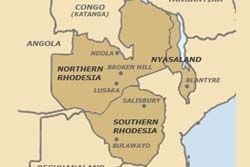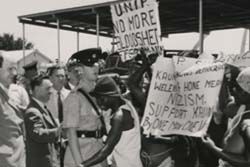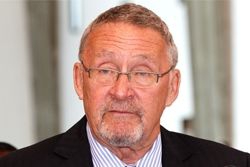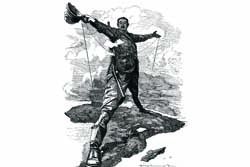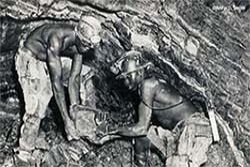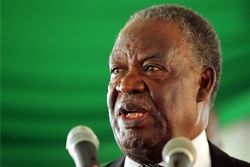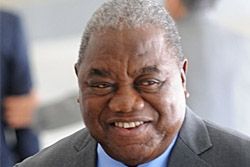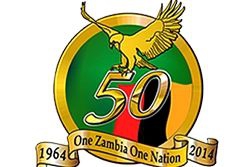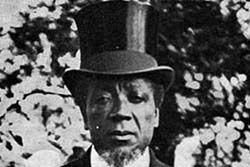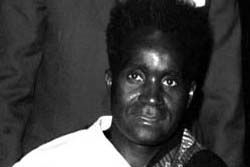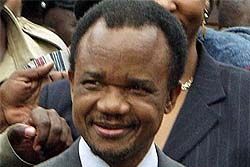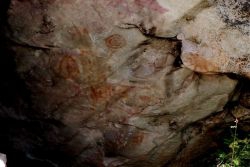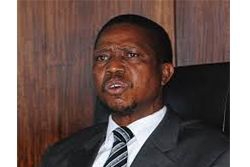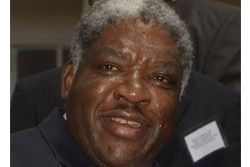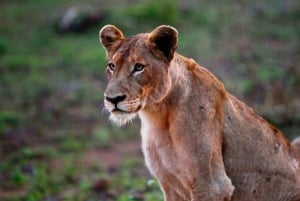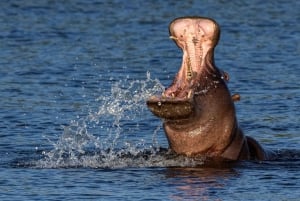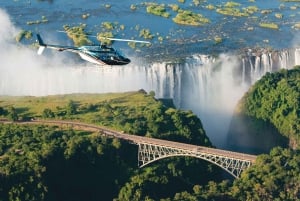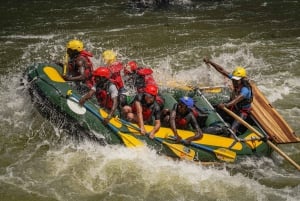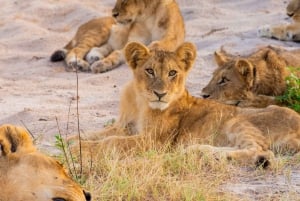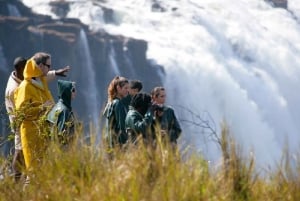History of Zambia
The early inhabitants of Zambia were stone age hunter gatherers living a semi-nomadic lifestyle. In approximately the 4th century AD Bantu speaking immigrants moved in from the north bringing iron tools and weapons and introducing slash and burn farming methods, growing crops; beans, sorghum, bananas and yams and tending livestock; goats and cattle. These settlers lived in small, almost self-sufficient villages of approximately 12 houses.
By the 11th or 12th centuries a more advanced iron age culture had built up and long distance trade was flourishing. Copper was being used as currency. By 1500 tribal kingdoms were developing, the largest being the Chewa in the east, the Aluyi, later to become the Lozi in the west, and the Bemba and Lunda in the north.
In 1482, the Portuguese naval captain, Diego Cao, sailing around the coast of Africa, noticed the effect the present day Congo River had on the sea, turning it a different colour and actually tasting fresh and not salty. Cao went ashore and made contact with the Kongo peoples of present day Democratic Republic of Congo. These newcomers brought new foods from America, maize and cassava, but they also exploited an already existing small scale slave trade. People became a tradable commodity and raiding parties captured members of other tribes to sell. Whilst no recorded Europeans had direct contact with Zambia during this period, the effects of this slave trade were felt by the people.
Early in the 18th century the Portuguese founded trading posts at Zumbo and Feira, the confluence of the Luangwa and Zambezi rivers on the eastern side of Zambia. The Chewa traded ivory and copper for cotton cloth.
Further south, during the early 1800s, Shaka, the ruler of the Zulu Kingdom started moving north in a conquering wave pushing fleeing tribes ahead of the raiding parties of Zulu warriors. The Kololo tribe crossed the Zambezi and, in 1838 conquered the Aluyi tribe. In Kololo speech Aluyi became Barotse. In 1864 the Barotse defeated the Kololo. The Barotse became the present day Lozi of Barotseland.
In 1835, a group of Ngoni, also fleeing from Shaka, crossed the Zambezi in the east of the country. During the 1860s and 70s the Ngoni conquered the Chewa tribe. During this period, the Bemba and Lunda were trading with the Arabs and other African tribes along the east coast selling ivory and slaves. This was a time of trading, raiding and invading.
David Livingstone travelled through Zambia on three expeditions from 1853 until his death near Lake Bangweulu in 1873. In 1855 David Livingstone was the first recorded European to see Mosi-oa-Tunya and name them Victoria Falls.
The “Scramble for Africa” between 1881 and 1914 was a period of occupation, colonization and annexation of Africa by European powers. In 1889 Cecil Rhodes set up the British South Africa Company (BSA Company) to exploit the mineral wealth of southern and central Africa. The unique butterfly shape of Zambia was formed as a result of agreements between Britain and Germany, Portugal and the Belgian King Leopold II as well as treaties made between Rhodes’ agents and African Tribal Kings and Chiefs between 1891 and 1894.
The Lewanika, King of the Lozi in western Zambia gave permission for BSA Company to mine in return for GBP2000 per year and protection from Ndebele raids. The protection and money were slow in coming but, in 1893, after a further Ndebele raid on the Lozi the British finally stepped in and dealt decisively with the Ndebele.
The Bemba and Ngoni refused to negotiate with the BSA Company and were eventually subdued by force.
North Eastern Rhodesia and North Western Rhodesia were formed in 1900. In 1911 the two were merged as Northern Rhodesia with Livingstone town, founded in 1905, as its capital.
World War I had a huge impact on the territory. 3 500 troops were recruited and upwards of 50 000 porters conscripted. Many never returned which placed a heavy burden on the remaining population. Rebellion amongst the Mambwe people in the northeast and opposition to the BSA Company from the white settlers partly resulted in the company handing over the responsibility of running the country to the British Colonial Office in London. Northern Rhodesia was now a protectorate and white settlement actively encouraged.
In the late 1920s rich deposits of copper and cobalt were discovered and by 1939 Zambia was the world’s main source of copper. More than half the able-bodied African male population were working away from home. In 1935 a strike by African mine workers at three mines left six dead and 22 wounded. In 1940 white miners went on strike for better conditions. The African mine workers decided to strike as well. This time, 17 miners died and 64 were wounded.
In 1935 the capital was moved to Lusaka bringing it closer to the mineral wealth of the Copperbelt.
Missionaries had been running schools since the late 19th century and in the 1930s the British government began to provide education. In 1942 only 35 Africans were in secondary education but there was a growing number of better educated Africans working as teachers, foremen, clerks and church officials. These groups formed welfare societies both in the mining towns and in the rural areas. These societies gave rise to the Northern Rhodesia Congress with members of the congress sitting on the African Representative Council, a body with no power but it did have a voice, criticising political and social conditions.
In 1948 the African miners founded a trade union, followed by the African railwaymen in 1949. Legislation confirmed that, unlike South Africa and Southern Rhodesia, African unions had the same bargaining powers as white unions. In 1949 the African National Congress (ANC) was formed.
In 1951 a Conservative government was elected in Britain and in 1953, despite protest from the Chiefs and the ANC, Northern Rhodesia (Zambia), Southern Rhodesia (Zimbabwe) and Nyasaland (Malawi) were brought together in the Central African Federation.
The government of the Federation was based in Southern Rhodesia with powers over the territories though Britain retained control over African land, education and political status. The federal parliament had 29 white MPs and 6 African MPs, 2 from each territory. The African MPs were given power to query legislation they considered racist and send it to London to be approved or vetoed.
During this period there was a perception that the copper profits from Northern Rhodesia were being channelled into Southern Rhodesia with little benefit to the north. The only major development in Northern Rhodesia was Kariba Dam, built between 1955-1959. The construction of the dam and the rising water resulted in mass resettlements of some 50 000 people.
In 1958 a group broke away from the ANC formed the United National Independence Party (UNIP) and a former teacher and civil servant, Kenneth Kaunda, took over leadership in 1961. In 1962, after a campaign of civil disobedience, an election gave Africans a majority in the legislature and the ANC and UNIP formed a coalition in a transitional government. In 1963 the Federation was dissolved and in the 1964 elections UNIP won with a decisive majority. The Republic of Zambia came into being on October 24th 1964 with Kenneth Kaunda as the first elected president.
Kenneth Kaunda, UNIP (1964 - 1991)
In the early years of independence Zambia’s economy flourished due to a rise in the copper prices. The collapse of the copper price in 1975, the effects of the Unilateral Declaration of Independence (UDI) by the Ian Smith Government in Rhodesia and resulting sanctions on Rhodesia, turmoil in neighbouring countries Angola, Mozambique, the Congo/Zaire and South West Africa/Namibia, a bloated bureaucracy, unqualified people in important jobs and various other problems resulted in increased debt and poverty. Kaunda had banned opposition parties in 1972. Zambia was a one party state with elections on a yes or no format. In 1990 Kaunda bowed to pressure and lifted the ban on opposition parties. In July 1990 the Movement for Multi Party Democracy (MMD) was formed. In the multi-party elections in October 1991 MMD won 125 of the 150 seats. In the Presidential election Fredrick Chiluba won 81% of the vote.
Frederick Chiluba MMD (1991 – 2001)
| 1991 |
Alliance for Democracy and Development (ADD) political party formed. Constitution changed to allow only two terms in government. |
| 1996 | The Zambia President must be a Zambian citizen born of parents who are Zambian by birth and the candidate may not be a tribal chief. |
| 1998 | United Party for National Development (UPND) political party formed. Present head Hakainde Hichilema. |
| 2001 |
The Patriotic Front (PF) political party formed as a breakaway party of the MMD. Forum for Democracy and Development (FDD) political party formed as a breakaway party of the MMD |
Levy Mwanawasa MMD (2002 – 2008) died in office.
Mwanawasa won the election, held on 27 December 2001, with 29% in a first past the post system.
Ran for a second term in the presidential election held on 28 September 2006. Michael Sata of the Patriotic Front was his main challenger. He received 42.98% of the vote.
The political insatbility in Zimbabwe resulted in an increase in tourists visiting Zambia and an influx of displaced farmers from Zimbabwe. These factors helped the Zambian economy during this period. Mwanawasa was the first African leader to publicly criticise President Robert Mugabe of Zimbabwe.
After a period of ill health an announcement was made that Mwanawasa had died on 19th August 2008.
Rupiah Banda MMD (2008 – 2011)
Rupiah Banda took over Mwanawasa's presidential responsibilities after Mwanawasa suffered a stroke in June 2008, and following Mwanawasa's death in August 2008, he became acting President.
He narrowly won the October 2008 presidential election.
The Word Bank names Zambia one of the world’s fastest economically reformed countries.
Michael Sata PF (2011 – 2014) died in office
Sata ran for President for the fourth time in the September 2011 elections. He won by 43% of the vote.
On 24 October 2014 Zambia celebrated 50 years of Independence. Celebrations slightly marred by rumours and denials about President Sata’s absence from the festivities. The rumours turned out to be largely true when, on 28th October 2014 news of Michael Sata’s death in a London hospital hit the headlines.
Guy Scott PF (2014)
Vice-President Guy Scott automatically became acting president for the constitutional term of 90 days. Emergency elections were held in January 2015. Constitutionally he cannot become the elected president as his parents were not born in Zambia.
Edgar Lungu PF (2014 - )
Edgar Lungu of the Patriotic Front beat Hakainde Hichilima of the United Party for National Development (UPND) by a very narrow margin (1.66%). Edgar Lungu will serve the remainder of Michael Sata's term in office. Elections will be held again in 2016.


